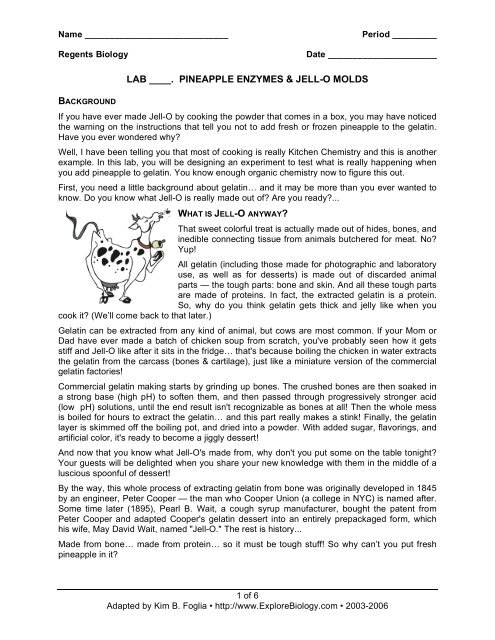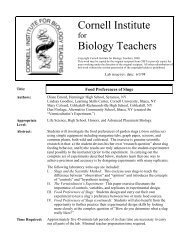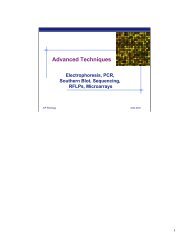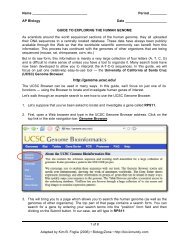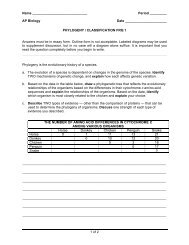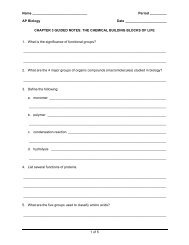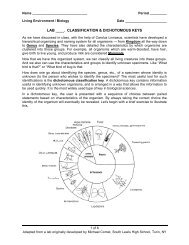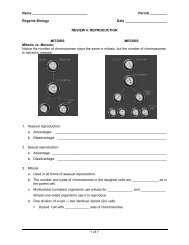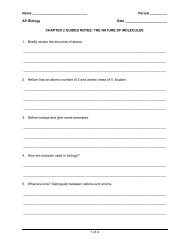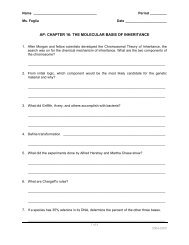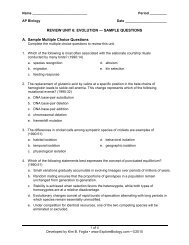pineapple enzymes & jell-o molds - Explore Biology
pineapple enzymes & jell-o molds - Explore Biology
pineapple enzymes & jell-o molds - Explore Biology
You also want an ePaper? Increase the reach of your titles
YUMPU automatically turns print PDFs into web optimized ePapers that Google loves.
Name _____________________________<br />
Regents <strong>Biology</strong><br />
Period _________<br />
Date ______________________<br />
LAB ____. PINEAPPLE ENZYMES & JELL-O MOLDS<br />
BACKGROUND<br />
If you have ever made Jell-O by cooking the powder that comes in a box, you may have noticed<br />
the warning on the instructions that tell you not to add fresh or frozen <strong>pineapple</strong> to the gelatin.<br />
Have you ever wondered why?<br />
Well, I have been telling you that most of cooking is really Kitchen Chemistry and this is another<br />
example. In this lab, you will be designing an experiment to test what is really happening when<br />
you add <strong>pineapple</strong> to gelatin. You know enough organic chemistry now to figure this out.<br />
First, you need a little background about gelatin… and it may be more than you ever wanted to<br />
know. Do you know what Jell-O is really made out of? Are you ready?...<br />
WHAT IS JELL-O ANYWAY?<br />
That sweet colorful treat is actually made out of hides, bones, and<br />
inedible connecting tissue from animals butchered for meat. No?<br />
Yup!<br />
All gelatin (including those made for photographic and laboratory<br />
use, as well as for desserts) is made out of discarded animal<br />
parts — the tough parts: bone and skin. And all these tough parts<br />
are made of proteins. In fact, the extracted gelatin is a protein.<br />
So, why do you think gelatin gets thick and <strong>jell</strong>y like when you<br />
cook it? (We’ll come back to that later.)<br />
Gelatin can be extracted from any kind of animal, but cows are most common. If your Mom or<br />
Dad have ever made a batch of chicken soup from scratch, you've probably seen how it gets<br />
stiff and Jell-O like after it sits in the fridge… that's because boiling the chicken in water extracts<br />
the gelatin from the carcass (bones & cartilage), just like a miniature version of the commercial<br />
gelatin factories!<br />
Commercial gelatin making starts by grinding up bones. The crushed bones are then soaked in<br />
a strong base (high pH) to soften them, and then passed through progressively stronger acid<br />
(low pH) solutions, until the end result isn't recognizable as bones at all! Then the whole mess<br />
is boiled for hours to extract the gelatin… and this part really makes a stink! Finally, the gelatin<br />
layer is skimmed off the boiling pot, and dried into a powder. With added sugar, flavorings, and<br />
artificial color, it's ready to become a jiggly dessert!<br />
And now that you know what Jell-O's made from, why don't you put some on the table tonight?<br />
Your guests will be delighted when you share your new knowledge with them in the middle of a<br />
luscious spoonful of dessert!<br />
By the way, this whole process of extracting gelatin from bone was originally developed in 1845<br />
by an engineer, Peter Cooper — the man who Cooper Union (a college in NYC) is named after.<br />
Some time later (1895), Pearl B. Wait, a cough syrup manufacturer, bought the patent from<br />
Peter Cooper and adapted Cooper's gelatin dessert into an entirely prepackaged form, which<br />
his wife, May David Wait, named "Jell-O." The rest is history...<br />
Made from bone… made from protein… so it must be tough stuff! So why can’t you put fresh<br />
<strong>pineapple</strong> in it?<br />
1 of 6<br />
Adapted by Kim B. Foglia • http://www.<strong>Explore</strong><strong>Biology</strong>.com • 2003-2006
Name _____________________________<br />
Regents <strong>Biology</strong><br />
Let’s learn a bit about <strong>pineapple</strong>. The <strong>pineapple</strong> plant (Ananas comosus) is a grass-like<br />
plant, that belongs to the bromeliad family. It is thought to have originated in Brazil. In<br />
the 1950s, <strong>pineapple</strong> became the United State’s second most important fruit and<br />
Hawaii led the world in both quantity and quality of <strong>pineapple</strong>s. However, times have<br />
changed and now, all canned <strong>pineapple</strong> comes from overseas, largely from the<br />
Philippines.<br />
As with some other tropical fruits, the <strong>pineapple</strong> fruit contains an enzyme that<br />
breaks down, or digests, protein. This protease enzyme in <strong>pineapple</strong> is called<br />
bromelain, which is extracted and sold in such products as Schilling's Meat<br />
Tenderizer. Papaya, another tropical fruit, also contains an enzyme, called<br />
papain, that digest protein. It can be found in Accent Meat Tenderizer.<br />
PROCEDURE:<br />
In this lab, you will be given an array of materials and you will be asked to design your own<br />
experiment to test the effect of <strong>pineapple</strong> on gelatin. The goal is to understand what is actually<br />
going on in the <strong>pineapple</strong>-gelatin mix at a chemical level as well as understanding what affects<br />
the function of <strong>enzymes</strong>.<br />
1. You will be given the following material<br />
Fresh <strong>pineapple</strong><br />
Canned <strong>pineapple</strong><br />
Jell-o<br />
Beakers<br />
<br />
<br />
<br />
<br />
Boiling & ice water<br />
Test tubes & rack<br />
Spoons, stirring rods<br />
Knife for cutting <strong>pineapple</strong><br />
2. Design a controlled experiment that shows the effect of raw <strong>pineapple</strong> on gelatin. Make sure<br />
your experiment description includes the following:<br />
a. An hypothesis. Remember hypotheses are written as “If…then” statements.<br />
b. A detailed experimental design which will include:<br />
1. The effect of fresh <strong>pineapple</strong> on gelatin.<br />
2. The effect of frozen <strong>pineapple</strong> on gelatin.<br />
3. The effect of canned <strong>pineapple</strong> on gelatin.<br />
4. The effect of freshly cooked <strong>pineapple</strong> on gelatin.<br />
5. A test to determine how gelatin behaves without any fruit additives.<br />
c. A data table<br />
3. Write up a detailed experimental plan on the accompanying sheet of paper.<br />
4. You will be able to perform your experiment once you receive approval of your experimental<br />
design from your teacher.<br />
2 of 6<br />
Adapted by Kim B. Foglia • http://www.<strong>Explore</strong><strong>Biology</strong>.com • 2003-2006
Name _____________________________<br />
Regents <strong>Biology</strong><br />
EXPERIMENT RESEARCH PROPOSAL FORM<br />
Teacher Approval ________________<br />
1. Title _______________________________________________________________________<br />
2. Team Members ____________________________________<br />
_________________________________<br />
_________________________________<br />
____________________________________<br />
____________________________________<br />
3. Research Relationship (What is affecting what?) ___________________________________<br />
___________________________________________________________________________<br />
___________________________________________________________________________<br />
4. Research Prediction (What results do you expect?) _________________________________<br />
___________________________________________________________________________<br />
___________________________________________________________________________<br />
5. Hypothesis (Be specific. Include a variable you are measuring. In an “If, then” form)<br />
___________________________________________________________________________<br />
___________________________________________________________________________<br />
___________________________________________________________________________<br />
6. Experimental Design (Describe your experimental procedures)<br />
a. ________________________________________________________________________<br />
b. ________________________________________________________________________<br />
c. ________________________________________________________________________<br />
d. ________________________________________________________________________<br />
e. ________________________________________________________________________<br />
f. ________________________________________________________________________<br />
g. ________________________________________________________________________<br />
3 of 6<br />
Adapted by Kim B. Foglia • http://www.<strong>Explore</strong><strong>Biology</strong>.com • 2003-2006
Name _____________________________<br />
Regents <strong>Biology</strong><br />
7. Independent Variable _________________________________________________________<br />
8. Dependent Variable __________________________________________________________<br />
9. What other factors must be controlled? ___________________________________________<br />
______________________________________________________________________________<br />
10. Data Table (Create a table to collect your data in.)<br />
11. Title of Data Table & Graph ____________________________________________________<br />
___________________________________________________________________________<br />
12. Proposed Plan to Analyze Data<br />
(In what way will you compare these numbers after you collect them?)<br />
___________________________________________________________________________<br />
___________________________________________________________________________<br />
___________________________________________________________________________<br />
13. Explain what results you would need to see in your data to support your hypothesis<br />
___________________________________________________________________________<br />
___________________________________________________________________________<br />
___________________________________________________________________________<br />
14. Complete the experiment. Collect the data in your Data Table. Graph your results if<br />
appropriate. Answer the Summary Questions.<br />
4 of 6<br />
Adapted by Kim B. Foglia • http://www.<strong>Explore</strong><strong>Biology</strong>.com • 2003-2006
Name _____________________________<br />
Regents <strong>Biology</strong><br />
SUMMARY QUESTIONS<br />
1. Clearly describe the results of your experiment. In which test tubes did the gelatin <strong>jell</strong>, which<br />
did not.<br />
___________________________________________________________________________<br />
___________________________________________________________________________<br />
___________________________________________________________________________<br />
___________________________________________________________________________<br />
___________________________________________________________________________<br />
___________________________________________________________________________<br />
2. Clearly explain the results of your experiment. Why did some containers of gelatin <strong>jell</strong>, why<br />
did others not. Be specific!<br />
___________________________________________________________________________<br />
___________________________________________________________________________<br />
___________________________________________________________________________<br />
___________________________________________________________________________<br />
___________________________________________________________________________<br />
___________________________________________________________________________<br />
___________________________________________________________________________<br />
3. What is the enzyme in your experiment? __________________________________________<br />
4. What is the substrate in your experiment?_________________________________________<br />
5. What is (are) the product(s) in your experiment?____________________________________<br />
6. What type of organic molecule is gelatin? _________________________________________<br />
7. What type of organic molecule is the enzyme, bromelain? ___________________________<br />
5 of 6<br />
Adapted by Kim B. Foglia • http://www.<strong>Explore</strong><strong>Biology</strong>.com • 2003-2006
Name _____________________________<br />
Regents <strong>Biology</strong><br />
8. Write a “word equation” to describe the chemical reaction that occurs when <strong>pineapple</strong> is<br />
mixed with the gelatin.<br />
___________________________________________________________________________<br />
9. Is the reaction of bromelain and gelatin synthesis (building) or digestion (breakdown)?<br />
___________________________________________________________________________<br />
10. Why were the results of the freshly cooked <strong>pineapple</strong> different than the results of the fresh,<br />
raw <strong>pineapple</strong>? Be specific! What happened to the enzyme?<br />
___________________________________________________________________________<br />
___________________________________________________________________________<br />
___________________________________________________________________________<br />
11. What is meat tenderizer and what does it do? Be specific!<br />
___________________________________________________________________________<br />
___________________________________________________________________________<br />
12. Explain what is meant by denaturing a protein.<br />
___________________________________________________________________________<br />
___________________________________________________________________________<br />
13. Design an experiment you could do in science class to test at exactly what temperature the<br />
<strong>pineapple</strong> enzyme denatures (unfolds). Be specific!<br />
___________________________________________________________________________<br />
___________________________________________________________________________<br />
___________________________________________________________________________<br />
___________________________________________________________________________<br />
___________________________________________________________________________<br />
___________________________________________________________________________<br />
6 of 6<br />
Adapted by Kim B. Foglia • http://www.<strong>Explore</strong><strong>Biology</strong>.com • 2003-2006


